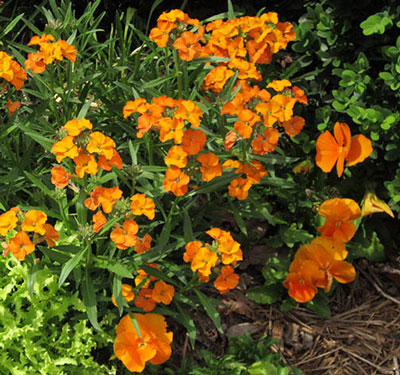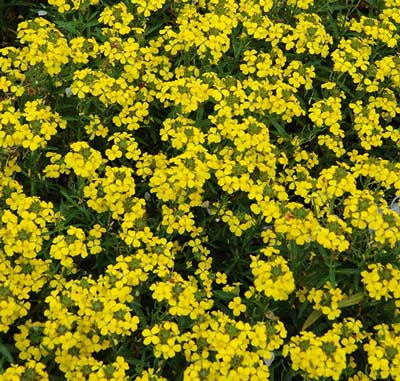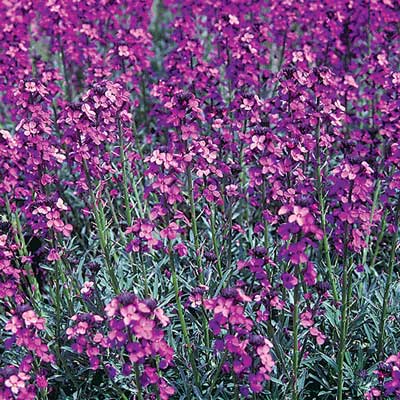From the Magazine: March 2015

‘Citrona’ wallflower comes in orange and yellow. Wallflowers tolerate the same winter temperatures as pansies. Photo by Mary Wilhite.
by Mary Wilhite
Waltz of the Wallflowers
These winter color plants are not shrinking violets
Tired of the same look in your winter flowerbeds and pots: pansies, pansies, pansies? Try planting some of the new varieties of wallflowers and be rewarded with great color and fragrance from February through June.

‘Precious Gold’ wallflower flaunts clusters of fragrant gold flowers atop gray-green foliage. Photo by Jenny Wegley.
Despite their name, wallflowers are not shrinking violets in the garden. They do not hide in the background, hoping to be invited to the party, but are out on the dance floor strutting their stuff. Planted in the fall, wallflowers will flaunt their party dresses of bright green or variegated foliage all winter long, then burst into bloom in early spring. Clusters of sweetly scented flowers appear in colors ranging from white, yellow, orange and red to purple. New flowers will continue to form for months if the old, spent flowers are removed.
Wallflowers got their name from their tough disposition and ability to live in the barest soil – in the cracks of walls. Here in Texas most varieties of wallflower are short-lived perennials, lasting several years in the garden. Some are best treated as cool-season annuals like pansies. All like a sunny, well-drained location and prefer to dry out before being watered.
Many types of wallflowers are available through Internet sales. Here are some of the best for our climate.
• Annual wallflowers (Cheiranthus cheiri) bloom in the fall, stay green all winter, then bloom again starting in early spring until the heat of summer sets in. The ‘Sugar Rush’ series comes in separate colors of red or yellow or a nice mix that includes orange, white and purple. Plants grow into dense clumps of green foliage 10 to 12 inches tall and 8 inches wide. Siberian wallflower (Erysimum allionii) ‘Citrona’ is available with flowers of bright yellow or orange, a perfect complement for bright-colored pansies.
• Variegated shrubby wallflower (Erysimum linifolium ‘Variegatum’) lights up the winter garden with leaves of bright green edged in yellow. Clusters of mauve and violet flowers persist throughout the winter in mild weather, but in a cold winter they may wait until February to unfurl their fragrant flowers. Once the flowers start, they continue for months.

Known for its drought tolerance and hardiness, ‘Bowles Mauve’ wallflower has been a Texas favorite for years. Photo by Heritage Perennials.
• ‘Bowles Mauve’ wallflower has been a favorite of Texas gardeners for a number of years due to its drought tolerance and hardiness. Slender gray-green leaves set off the profusion of fragrant mauve flowers that continue for months and attract butterflies. Plants develop a woody base and should be sheared back to 6 inches in early summer to promote a flush of new foliage and fall flowers. Mature plants will grow up to 30 inches tall and wide and are a great addition to a water-wise garden.
Several new wallflower hybrids that have been developed in the last few years are worth trying for interesting fall, winter and spring color.
• Recently introduced from New Zealand, Erysimum ‘Apricot Twist’ blooms have a blend of orange and apricot flowers opening from purple buds. Jagged gray-green leaves grow into a compact mound.
• ‘Jenny Brook’ grows 15 to 18 inches tall with emerald-green linear leaves and large flowers standing above the foliage. Purple buds open to peach and rosy-pink flowers, then turn back to purple. Each plant shows the full range of colors simultaneously for a glorious show the entire spring.
• ‘Honeyberry’ is a new introduction with habit and flower color similar to ‘Jenny Brook’, but with vibrant, yellow edges on the bright green leaves.
• The Winter™ series of wallflowers was developed for stockier plants, larger flowers and longer bloom time. This series provides the tallest plants with the largest flowers. Winter ‘Sorbet Improved’ produces fragrant flower spikes with individual flowers an inch wide that emerge rusty orange and mature to shades of purple, with all the various hues appearing on the plants at the same time. These plants make a showy backdrop for lavender or pink pansies.
• The Glow™ series is another new hybrid bred for bright color and a long bloom period. This series stays low to the ground and spreads to 15 inches wide. Small, honey-scented flowers in a range of citrus colors stand above the green foliage. These perennials are very drought tolerant.
Popular with English gardeners for many years, wallflowers are just now being discovered and appreciated by Americans. Try some in your garden this spring, and you will be searching for more varieties in the future.
